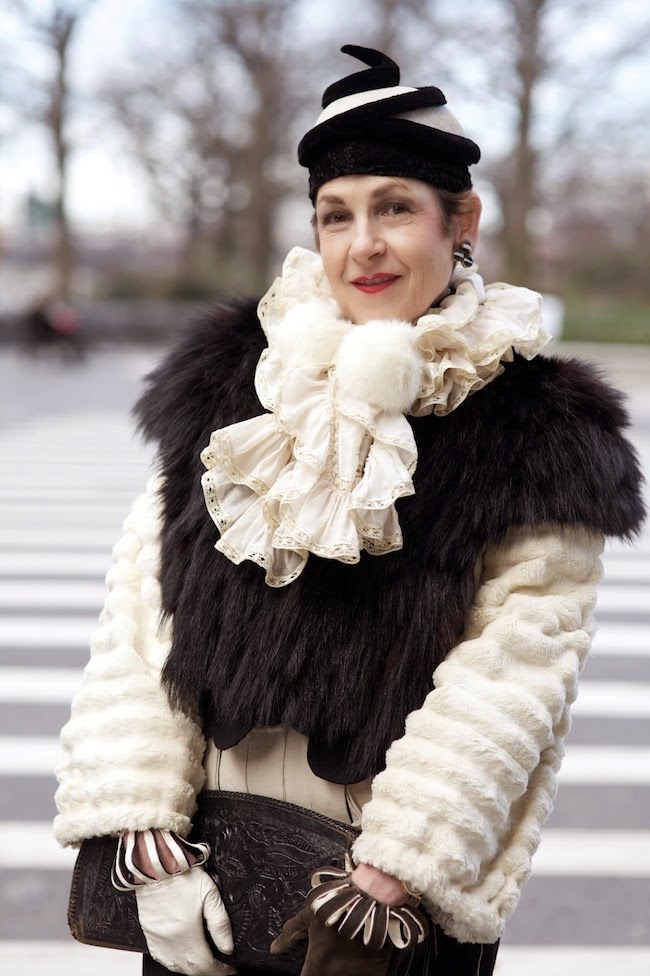 Die Mode, die dieser Tage über die Laufstege läuft, sieht nicht aus wie für alte Damen gemacht. Alles wirkt so jugendlich und frisch, die geschlitzten Röcke, die bunten Sneaker, die entblößten Schultern, die Plateausandalen. Ebenso gelten schließlich auch nur junge Menschen als avantgardistisch, ältere Herrschaften dagegen als zurückhaltend beigefarben. „Wieso ziehen sich nicht alle Seniorinnen an wie Sie?“, fragte ich die aufregendste Stilikone, die mir in meinem Leben je begegnet ist, beim Treffen im New Yorker Kaufhaus Bergdorf Goodman. Mit Tziporah Salamon, 64 Jahre alt und springlebendig wie ein Flummi auf Koffein, hatte ich mich im 7. Stock zum Teetrinken verabredet. Wir saßen an einem Tisch direkt am Fenster und schauten über den Central Park. Tziporah trug ein rot-blau-gestreiftes Wollmützchen, einen viktorianischen Spitzenkragen, ein dunkelblaues Comme-des-Garçons-Top mit gewellten Säumen, dunkelgraue Culottes, weiße Söckchen und schwarz-weiße Budapester mit Fransen. „Honey“, sagte sie und lächelte freundlich. „I don’t understand your question. So many young people out there don’t know how to dress well. It’s not a matter of age. It’s all a matter of attitude.“
Die Mode, die dieser Tage über die Laufstege läuft, sieht nicht aus wie für alte Damen gemacht. Alles wirkt so jugendlich und frisch, die geschlitzten Röcke, die bunten Sneaker, die entblößten Schultern, die Plateausandalen. Ebenso gelten schließlich auch nur junge Menschen als avantgardistisch, ältere Herrschaften dagegen als zurückhaltend beigefarben. „Wieso ziehen sich nicht alle Seniorinnen an wie Sie?“, fragte ich die aufregendste Stilikone, die mir in meinem Leben je begegnet ist, beim Treffen im New Yorker Kaufhaus Bergdorf Goodman. Mit Tziporah Salamon, 64 Jahre alt und springlebendig wie ein Flummi auf Koffein, hatte ich mich im 7. Stock zum Teetrinken verabredet. Wir saßen an einem Tisch direkt am Fenster und schauten über den Central Park. Tziporah trug ein rot-blau-gestreiftes Wollmützchen, einen viktorianischen Spitzenkragen, ein dunkelblaues Comme-des-Garçons-Top mit gewellten Säumen, dunkelgraue Culottes, weiße Söckchen und schwarz-weiße Budapester mit Fransen. „Honey“, sagte sie und lächelte freundlich. „I don’t understand your question. So many young people out there don’t know how to dress well. It’s not a matter of age. It’s all a matter of attitude.“
Kleider machen Leute, aber Mode macht keine Stilikonen. Das wissen die Erfinder der brandaktuellen Céline-Kampagne, die statt eines gesichtslosen Supermodels die amerikanische Schriftstellerin Joan Didion zeigt. Das weiß Ari Seth Cohen, der lange vor Céline verstanden hat, dass die bestgekleideten Frauen in New York die 50 längst überschritten haben und ihnen deshalb ein Blog namens „Advanced Style“ gewidmet hat. Und das weiß, natürlich, eine Frau wie Tziporah, die seit Kindertagen Kleider sammelt und ihre Garderobe „Archiv“ nennt. Aus unzähligen Hüten, Kragen, Schnürschuhen, chinesischen Seidenmänteln und japanischen Obi-Gürteln kreiert sie allmorgendlich ein neues Kunstwerk.
Nebenbei ist „Tzippy“ übrigens nicht nur tausendmal aufregender gekleidet als jede siebzehnjährige Fußgängerzonenbesucherin, jede halbwüchsige Modebloggerin und jede ausgewachsene Vogue-Redakteurin, sondern dabei auch noch dynamisch wie ein Hochleistungsathlet. Alle fünf Minuten springt sie auf, die Teetasse klirrt, Tziporah muss irgendwas in Bewegung erklären, einen Handschuh zeigen, der im Eifer des Gefechts hinterm Stuhl gelandet ist, dann dreht sie sich im Kreis und schüttelt ihren hübschen Spitzenkragen, mit dem sie aussieht wie ein Harlekin. Die Bergdorf-Damen, die sich am Nebentisch vom Einkaufen erholen, gucken schon.
Nach dem Interview (siehe unten) fahre ich hinunter in den ersten Stock, schlängele mich durch die Handtaschenabteilung und trete hinaus auf die 5th Avenue. Beschwingt spaziere ich durch die abendlichen Straßen von New York. Dann kaufe ich einen Hut. Und beschließe, meinen Kleiderschrank fortan Archiv zu nennen.
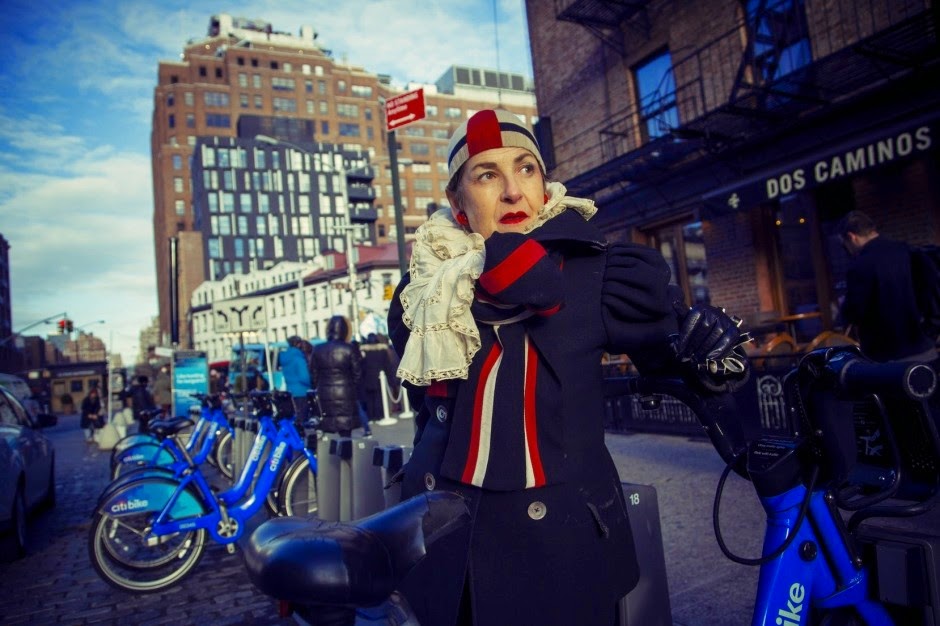 Miss Salamon, what are you wearing today?
Miss Salamon, what are you wearing today?
I am wearing – should we start with the hat or the shoes? – I am wearing Ann Demeulemeester shoes, but I added the fringes. They came without these. I bought these shoes probably six years ago at Barneys, and this is the first time I am wearing them. I don’t know why I haven’t worn them yet, but I am a big proponent of “Don’t give away and don’t throw away” because you will always regret it. Because I do. Every time I’ve given something away, I regretted it. These white socks are Comme des Garçons – my favorite brand.
Why Comme des Garçons?
I discovered Rei Kawakubo when I first moved back to New York in 1979. She’s always been my go-to-designer, she never disappoints. Sometimes she’s too out there for me and I can’t wear it, well, first of all, money-wise she’s totally out there for me, but even taste-wise sometimes her own collection is… you know, she’s an artist, so she keeps on pushing the boundaries… sometimes I find the clothes of her own line unwearable, but the Play line is my favorite, it’s always a mix of basics and wonderful classics. She’s also great for accessories, so even if I can’t afford anything, at least I can buy a pair of socks – like these, they were $65!
These knickers look great. Where did you get them?
Oh, that’s actually a nice story. I came back to New York in 1979 – before, I had been living in California for seven years, where I was getting a Ph.D in Psychology at Berkeley University. I’m originally from Israel. Until I was 9 years old, we lived in Israel, then we moved to Brooklyn, I went to high school there and college in Buffalo and after college I moved out to California. I came back to New York when I was 29 to pursue fashion. My third job was at Barneys. Barneys was incredible. It was small, only two floors. I was a sales girl there and I used to watch the elevators’ doors open and see the best dressed women in the world get off those elevators. It was like a runway! Anybody who was anybody in the world, in the arts, fashion, in theater, you know, any woman that I would aspire to, walked through those doors. It was a fantastic education. As sales assistants, we were allowed to buy the clothes half-off. This was 1982, and an Armani women’s suit came in, it was 800 Dollars. I got it for 400. These are the knickers, the bottom.
You have been wearing them since 1982?
Oh yes! I love them, because you can wear them with socks which adds an interesting twist. But the matching jacket I sold off my body for 3000 Dollars to a client who was a little mad, a little crazy, and money was no issue, she was one of the richest women in the world. Everything I had, she wanted. She said: I want that jacket. I said, It’s not for sale, she said, I give you a 1000 Dollars. I said, No. That was in 1992, I had bought the suit 10 years ago! She kept on insisting and finally offered me 3000 Dollars, and I sold it. To this day I am sorry about this, because this jacket was as good as these knickers – to this day, I live in these knickers. I could sleep in that jacket and the next morning I would wake up and I was good to go.
So you are wearing a lot of history on your body!
Oh yes, I always do. Either my own history, or fashion history. This volant collar is from the 1860’s. This vest is Comme des Garçons, it’s from last season. It was THE season, they had this three-dimensional theme, most of it was pink and blue. I wanted the whole collection. I was lucky to find one thing that I could afford. Underneath I am wearing a white sweater from the flea market – I needed it because I needed this, the fringe at the seam. It completes any outfit. For me, it takes years until an outfit is perfect.
Would you consider dressing up as an art form?
Yes, for sure. I don’t wear a certain item until I’ve found something to combine it with. Like a painter, who mixes different colors until he has the perfect tone. An outfit is like an artwork, it’s a painting. And I paint. The hat is Hermès. It’s contemporary, at this point it’s maybe 15 years old. They copied their own 1920’s design. The jewelry is vintage, my parents’ rings, another ring… that’s it.
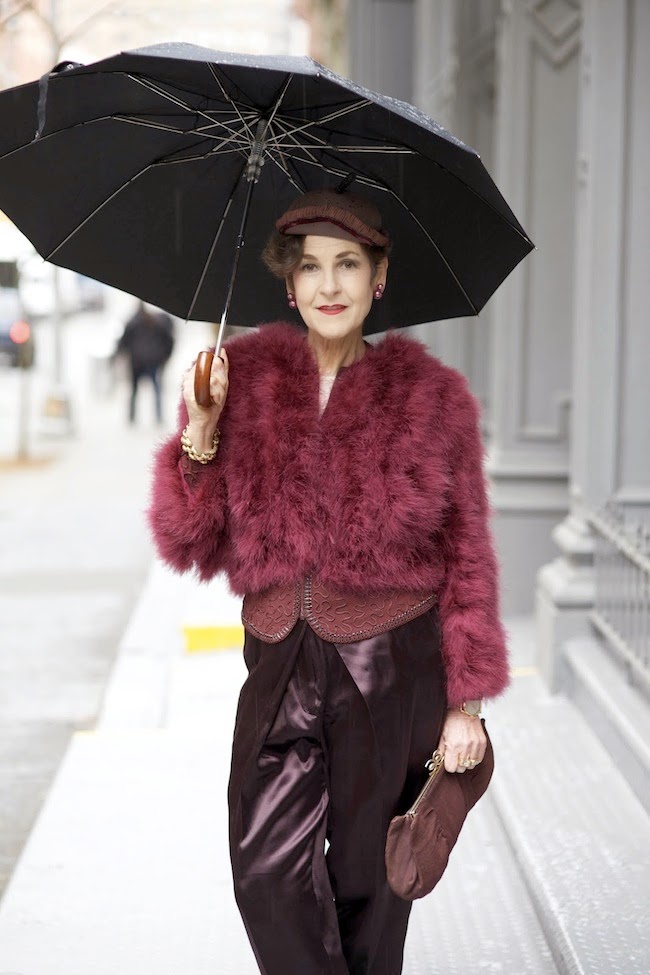 Do you follow what happens on the runways and around the fashion weeks? Would you consider fashion as an art form? Because in the end, fashion is still a product meant to be sold…
Do you follow what happens on the runways and around the fashion weeks? Would you consider fashion as an art form? Because in the end, fashion is still a product meant to be sold…
I think that very few designers actually make fashion an art form, and very few of these people running around at the fashion weeks make their outfit into an art form either. Fashion is about commerce, and most people follow trends, they do not pursue an artistic style.
I follow very few designers. I look at Comme des Garçons, obviously, I like Valentino – I think they are brilliant, what they do is actually what I have in my closet, but in a contemporary way. Their embroidery, their technique – it’s amazing! I own things like that from the early 1900’s, and now they reproduce it for a contemporary audience. I also like Junya Watanabe and Yohji Yamamoto, one of my favorites. But I am not interested in these overhyped fashion brands everyone wants to get an It-bag from.
Like Céline?
Oh, you know, don’t get me wrong, I think Céline is the new Balenciaga, just for the record. I think Phoebe Philo is brilliant, there are pieces from Céline that I would love to own. I hope to one day be able to afford one of these 3000 Dollar jackets, and I will. But I think the problem is that Céline has become like a uniform.
„I am not interested in fashion. I am interested in style“
You mean everyone is buying Céline not because of the design but because of the brand, and because they want to be part of the hype around it?
Exactly. I think trends have destroyed the fashion world. If one of my clients who I work as a stylist for wants to wear Chanel earrings with the C-C-logo, I always tell them, Why don’t you just put a 1000 Dollar bill on your ear? You might as well do that, clip a 1000 Dollar bill onto your ear and it’s as good as the C-C logo. Why are you wearing C-C earrings, for what, it’s not even pretty! To show everyone that it’s worth a 1000 Dollars, or whatever it is? And it’s the same with the It-bag, Céline started it five years ago or so, Louis Vuitton has it with his monograms on it, they all have it. That’s fashion. But you know, I am not interested in fashion. I am interested in style. That’s a huge difference.
Where do you shop?
Flea markets, antique shows, shoes at either Bergdorf or Barneys. I go a lot to the peer shows, and events like the Manhattan Vintage Show which happens three times a year. I buy one or two pairs of shoes a year, and then, of course, what I have to have and can’t resist. Like these glitter hats, they are from the 1930’s, I had to have them (she pulls two glitter hats out of her bag).
You always wear a hat, but in general, the hat seems to have died out on the streets. What would you tell someone who is afraid of wearing a hat?
You get noticed, you are different. You want to get noticed? Forget about your cleavage, wear a hat. You want men to notice you? Wear a hat. Men love women with hats – not matter how old or young they are. Hats are sophisticated. And they are fun. They are the explanation mark. You know – the baker, for example. How do we know he is a baker? Because of his hat. The police man – how do we know he’s a police man? Because of his hat.
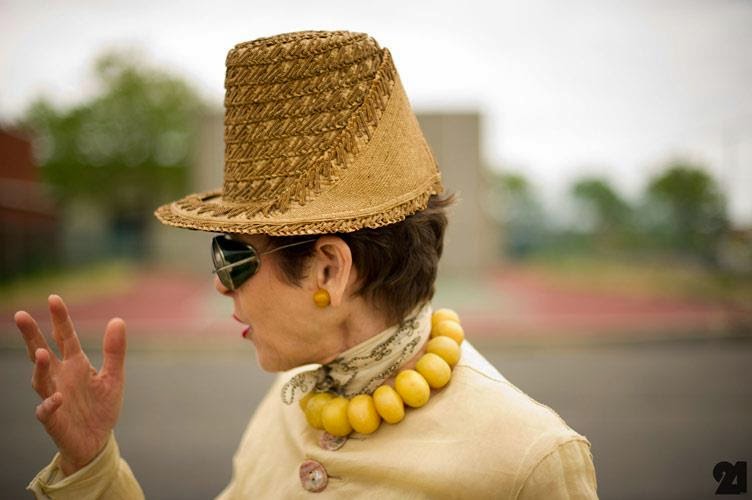 Why have people stopped wearing hats?
Why have people stopped wearing hats? I can only speak for America, because this is where I grew up. When the Vietnam war happened, we all took over the administration buildings, we protested against the war – a hat would have looked too polished in this context. It’s all about the casualty, the dressing down and the fattening up of America – and America leads the world, unfortunately. Hats are considered to be too formal nowadays.
You grew up in Israel, your father was a tailor, your mother a dressmaker. How has your upbringing shaped who you have become today?
What happened to me, the way my life started out – I was destined to become who I am. I was born in a time that is really historical, in 1950. Israel was born in 1948. So that was an incredible time to be growing up alongside a country. There were no stores yet in Israel, you had to go either to a tailor or a dressmaker. So as a baby, while I was sleeping, my parents were literally sewing my clothes. My father who wanted a boy sewed little boys’ clothes for me. My mother sewed wonderful little girls’ clothes for me. My parents are both Holocaust survivors, they survived the camps. My father sew the Nazi uniforms, that’s how he survived, so you know how good he was, because these uniforms where very exact. My father’s sister was in Auschwitz. She survived and came to America after the war. And she happened to marry the vice president of Neiman Marcus, which owns Bergdorf Goodman. We would get packages from my very rich aunt from the department store.
You must have been the best dressed girl in town.
Oh yes, I was indeed. From day one what I had on my back was couture clothes. Literally sewn by couturiers, because my parents were good enough to work with any couture house. My mother could not just sew, she could embroider, she could crochet, she could knit. And then my aunt sent the best clothes that money could buy from America. So, from day one I played with clothes, I grew up with clothes, I went to sleep and woke up finding another pants, another dress, another skirt. I was the best dressed girl in town, I was the best dressed teenager in high school, so I was born with this.
 So you were obviously very gifted. But what do you tell the people who take part in your seminars in which you teach about how to dress well?
So you were obviously very gifted. But what do you tell the people who take part in your seminars in which you teach about how to dress well?
In the seminars, I start with basics. I start with black pants and a black top. I basically show the elements of design, I explain proportions, silhouettes, texture, color, why does this work with this and not with this. I explain and I show. What happens when I add high heels, why does this silhouette proportionally work with flats, or why doesn’t it? What happens if I put a belt on this outfit, why does this not work with a belt, why does this yes work with a belt. I show all this by using my clothes.
„Those who know how to dress don’t need a mirror“
Would you say that getting dressed is a rather technical process?
No, I would say it’s an innate process: those who know how to dress know how to dress, and they don’t even need a mirror. Those who don’t know how to dress need a teacher. They can learn it. If the girls are smart enough to copy me, they get better. Everyone needs a role model.
What kind of women come to your seminar?
It’s a mix. It’s definitely older women, who want to revive their whole notion of style, how they can dress… but’s is also young women. More and more the word is spreading about me. I get a lot of fan letters from younger women, telling me how inspirational they find me.
I give women permission to dress. After they see me, they’re like, I want to dress, I want color. So they go into their closets and they start dressing. They start playing with clothes again. And that really is the joy of dressing. It’s all about playing. Playing dress-up! Just what we did in our mother’s closets when we were little girls.
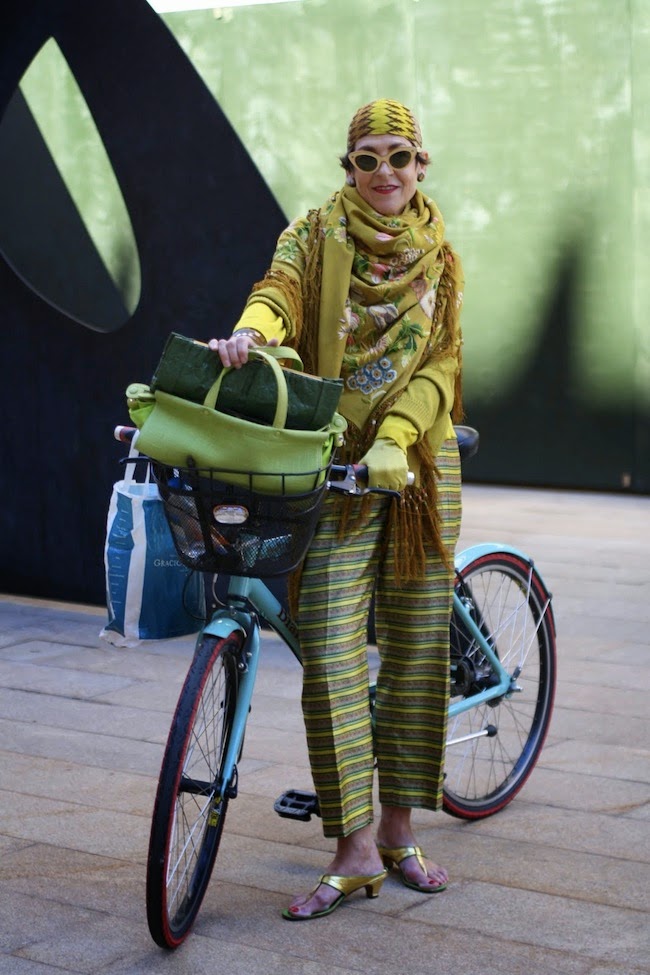 You have a lot of experience in dressing. What is the greatest lesson you have learned about style over the years?
You have a lot of experience in dressing. What is the greatest lesson you have learned about style over the years?
I really believe that it all lies in the details. When I arrived in New York, I did not have a lot of clothes. I was wearing this Armani suit every day, just changing the accessories around it. That’s actually what men do, they have one suit and then they change the tie and the pocket square around it. Parisian women embrace that kind of dressing, too. Over the years, as more money came in, and definitely as I started to know who I was and what I liked, my style evolved. For example, it was a real revelation for me that all hats actually looked good on me! It took me some time to realize that I have a hat face. So I was buying all these hats, and then I learned that I do not like hats from the 40’s, because in general, clothes from that time just don’t work on me. You know, the big shoulders and the narrow waist. I don’t have a small waist and I don’t like myself in a skirt. I’m a biker, so I need pants. So I said to myself, Honey, you should stop buying 40’s hats, because you don’t wear 40’s hats! That was a revelation, up until then I hadn’t realized that. It just takes years to know what looks good on you and what does not, it takes years to find out what clothes actually match your personality.
How would you describe the essence of you style?
First of all, I dress very artistically. Also, it’s always bold, you know, I’m not a wall flower, I really stand out. Stripes are a huge theme in my life; Pierot – today I’m actually Pierot, the clown, that’s a huge theme for me, it’s my favorite, I do it a lot – Charlie Chaplin is one of my icons, so I try to do Charlie as good as I can. Later in life, I discovered Chinese clothes. I love Chinese style, there isn’t anything better than Chinese Vintage. The embroidery of Chinese clothes, it just doesn’t get any better. So I wear Chinese a lot, I wear Persian a lot, I love coats. I’m more interested in ethnic clothes right now than in European style.
„If you wear the the wrong outfit, it will hold you back the whole day“
Is there anything you don’t allow yourself, anything you don’t dare to do?
I dare everything, but I’m not interested in mini skirts, I’m not interested in showing cleavage, not interested in any gowns, whatsoever, especially strapless – I have never been.
Do you dress for yourself or for an audience?
Oh, for myself! I’ve always dressed for myself! Everything I put on my body has to express who I am, otherwise I just don’t feel comfortable. Whenever I feel uncomfortable in what I’m wearing, I’ll go home and change. Your outfit can totally change how you feel. And once you feel good and confident, you can actually forget about that! Only if somebody stops you and says, You look great! you remember it must be because of what you’re wearing. If you wear the wrong outfit it will hold you back the whole day.
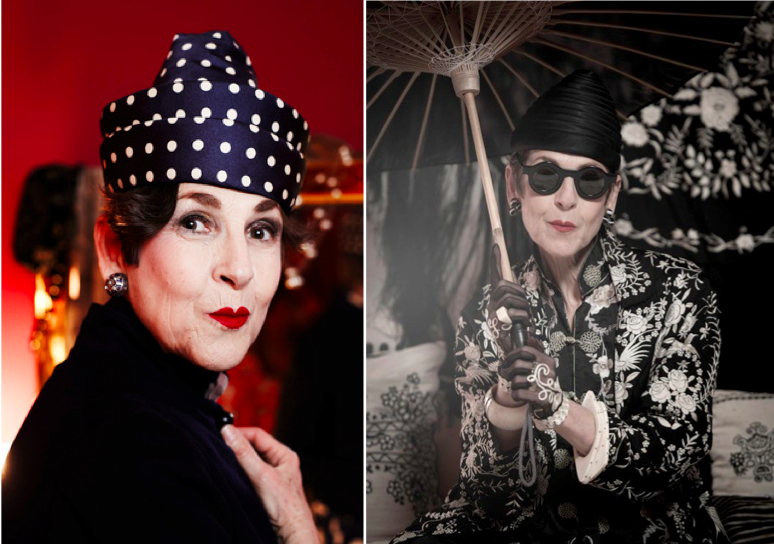 You once said you think a woman should always look like a lady. What does that mean in our contemporary context? What is a lady?
You once said you think a woman should always look like a lady. What does that mean in our contemporary context? What is a lady? A lady does not look overtly sexy or trampy, which a lot of women do nowadays. She is not stuck in black workout clothes all day, showing whatever you don’t want to see. I don’t find this attractive, even if you have the best body. You know, sometimes I look at women and they are half-nude, wearing a slip dress or hotpants, and then I’m like: Why? Save that for the bedroom! They want to get fucked. Even the shoes, these high heels are fuck-me-shoes, although most women can hardly walk in them. A lady, however, dresses for herself, not for someone else.
„A lady dresses for herself, not for an audience“
Has the lady died out today?
Yes and no, I mean, depending on where you’re looking. Certainly if you go to the Synagoge, where I go on Friday evenings, you would not say the lady has died out. If you go to a Jewish function, women are still dressing very well. It really depends on where you look.
I actually often experience that people do appreciate if someone has put an effort into dressing – but they would never do it themselves, they keep on wearing jeans and t-shirts everyday. Is it just laziness or does this reflect the common prejudice of fashion being meaningless?
I don’t think it’s laziness. I think it has to do with self-worth, and I think it has to do with priorities. I have a friend I’ve been knowing since we were 20, we were roommates in Israel in a programme called “Junior year abroad”. She was a hippie and came with one backpack for the entire year. And I came with a trunk that I had made for myself with all these clothes that my mother had made for me. So she was like, What is this? She had absolutely no interest in clothes. Then she became very fat, she gained a lot of weight. And she really just wore mumus. But now she’s just lost 56 pounds, and as we just talked yesterday, she said, You know what, you’d be so proud of me, I’m dressing. I love to dress. It’s because of you that I’m finally seeing the joys of dressing. She never allowed herself that. First of all, she thought it was politically incorrect when she was in her twenties, and then she gained all this weight. But now that she has lost this weight and starts to love herself and work on herself, she’s like, Oh, this is like a joy that I can give myself that I never had.
„Dressing well opens doors. People love you, you love them, it’s a whole loop of love!“
So you mean dressing well is about paying respect to yourself?
Absolutely. It’s about valuing yourself. I know for myself that if I’m down, dressing always puts a smile on my face. If nothing else, I can look down on myself and be happy about what I’m wearing. So it gives me joy, it gives my eyes joy, dressing really gets me out of bed – more than breakfast! It’s also a way to attract people. I get people stopping me all the time. I don’t dress for others, but attracting people is one of the great side-effects of dressing well. When I was in Paris for the Lanvin show two years ago, I stayed with friends, but I did all my business at hotels. So I would just go to the concierge and ask, Excuse me, how do I get to my next destination? They would look it up, print it out for me, they always treated me as if I was a guest. I wasn’t a guest, I just hang out in the lobby. Wherever I go, people appreciate me because I’m dressed well. Sometimes completely random people stop me to tell me I made their day because of my outfit. It opens up doors, people approach you, people love you if you dress well. People love you, you love them, it’s a whole loop of love!
Is that what you tell people when they say they find fashion irrelevant?
Absolutely. You know, dressing well is a creative activity we get to do on a daily basis. I get to do a painting every single day. Every morning. I always consider first, Who am I going to be today, am I going to be Pierot, or am I going to be a Chinese empress… In Israel, there is a Jewish holiday called Purim. It’s a holiday on which everybody gets dressed, especially children. My mother made my outfits, she made the shoes, she made the hats – look, this is a photo of me being 2 years old, and I am dressed as Snow White. Here, I am a doughnut. The entire costume is made of brown crepe paper. Here, I’m a Persian princess. My mother was Philo. So when you grow up like that, with that mother…
…how would you not end up in fashion.
Not fashion. Well, I actually worked in fashion for many years, but I dropped out, because I couldn’t find a job to suit me. So I kind of created my own.
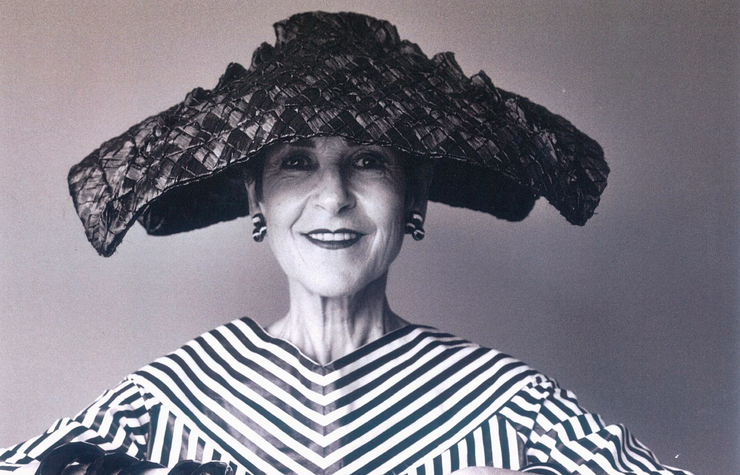
How would you describe your profession? What’s your job title?
I think first I’m an artist. But it actually took me years to get where I am now. I think what I do is what painters do in a painting. But I don’t use paint, I use scarfs and hats and fabric, jewelry. I’m also a story teller, I happen to have an incredible life. I tell very good stories and I have very good stories. That’s also the reason for why I’m doing a One-Woman-Show based on my life. So I have that, I have the seminars in which I teach women how to dress. I do these seminars at least once a month. One seminar is 3 hours and costs 150 Dollars per person. Also, women hire me to style them, so I work as a stylist, I just worked with an actress yesterday.
What is your show about?
I’ve been doing it for 8 years, but now, for the first time, I’m working with a director. It’s a sartorial autobiography show. It starts with my life in Israel, with these two incredible parents that I had. I show a lot of those pictures from when I was a little girl. Then I move to America and what that was like. Then what it was like in high school, what it was like when I went to college. I’m either showing pictures of what I wore or putting on the clothes. I still have the clothes from when I was an undergraduate student! My mother made me this incredible wardrobe for college in Buffalo. She knew it would be very cold there, so she made me a lot of culottes and capes. Then I go on to what happened to me in my twenties, when I was a hippie in Berkeley, California. Then I have a 15 minutes session in which I put on music and strip down to a 1920’s bathing suit. I have all my clothes and accessories lined up on a clothing rack, so I totally strip down to this bathing suit and then I put on the next outfit.
So you perform the art of dressing on stage.
Right there. I tell and act my story. I’m a pretty good actress.
Last question: What advice would you give me today?
Oh, but you look great!
Thank you. But honestly, what would you change?
Put on a hat!
 Streetstyle-Bilder von Ari Seth Cohen
Streetstyle-Bilder von Ari Seth Cohen

